-
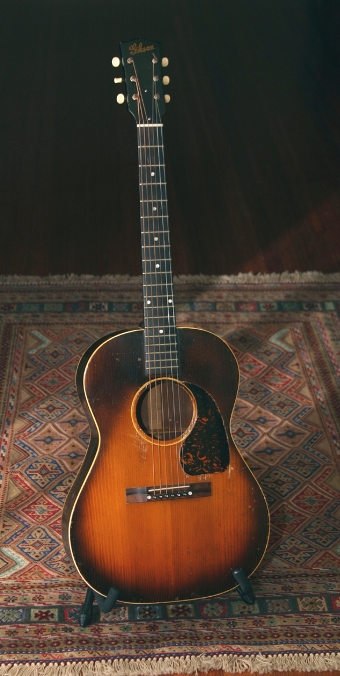 (No serial number or FON, these years often do not have one.) This completely crack-free, Script logo LG-2 is a jewel. A lot of players say the script logo Gibsons from right after the war are better sounding and better-built guitars than the Banner Gibsons. All of the good things about Banners, but with better craftsmanship. All original finish, everywhere. Mahogany back and sides. Spruce top. Not a crack anywhere. 1-3/4" nut. The bridge is an excellent quality rosewood replacement. Original maple plate. Original tuners. Replaced nut and saddle. Rosewood fingerboard shows moderate wear on first couple of frets. Some of that wonderful Gibson 40’s crazing to the finish, but not at all out of hand. Various pick marks, and dings. Original tuners, bridge, plate. Piezo pickup was skillfully de-installed, and endpin jack removed and plugged. One of the finest Script logo LG-2s you’ll find.
(No serial number or FON, these years often do not have one.) This completely crack-free, Script logo LG-2 is a jewel. A lot of players say the script logo Gibsons from right after the war are better sounding and better-built guitars than the Banner Gibsons. All of the good things about Banners, but with better craftsmanship. All original finish, everywhere. Mahogany back and sides. Spruce top. Not a crack anywhere. 1-3/4" nut. The bridge is an excellent quality rosewood replacement. Original maple plate. Original tuners. Replaced nut and saddle. Rosewood fingerboard shows moderate wear on first couple of frets. Some of that wonderful Gibson 40’s crazing to the finish, but not at all out of hand. Various pick marks, and dings. Original tuners, bridge, plate. Piezo pickup was skillfully de-installed, and endpin jack removed and plugged. One of the finest Script logo LG-2s you’ll find. -
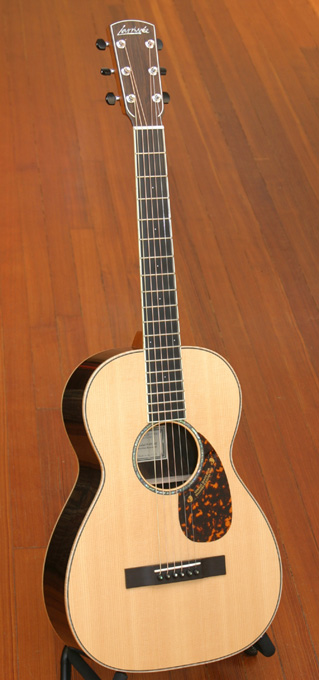 Mint condition. Period. Exceptional Larrivee 12-fret parlor guitar with a straight grained Sitka Spruce top and beautifully figured Brazilian Rosewood back & sides. Part of a very limited run of guitars built of high grade old stock Brazilian rosewood. Abalone rosette and tortoise shell pickguard. Ebony bridge w/ compensated saddle. Mahogany neck w/ microdot inlays, ivoroid bound ebony fingerboard, 1-3/4" nut, 24-1/4" scale, 13-1/4" lower bout, Larrivee logo peghead inlay, chrome tuners w/ebony buttons.
Mint condition. Period. Exceptional Larrivee 12-fret parlor guitar with a straight grained Sitka Spruce top and beautifully figured Brazilian Rosewood back & sides. Part of a very limited run of guitars built of high grade old stock Brazilian rosewood. Abalone rosette and tortoise shell pickguard. Ebony bridge w/ compensated saddle. Mahogany neck w/ microdot inlays, ivoroid bound ebony fingerboard, 1-3/4" nut, 24-1/4" scale, 13-1/4" lower bout, Larrivee logo peghead inlay, chrome tuners w/ebony buttons. -
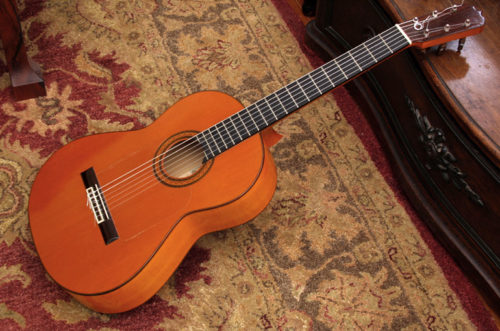 Martin established the X-brace as the standard in American guitars, but that was never pre-ordained, or set in stone. The fan-bracing of the Spanish guitar has equally appealing qualities, and is a century-plus long standard that continues to dominate the design of the classical and flamenco guitar. Not an “Estudio” (student) model, this is the top of line model, 1a Ramirez flamenco. If you’ve never played one of these exquisite cypress Ramirez flamenco guitars–you’ll be surprised at the tone. Spanish cypress back and sides. Cedar top. First of all, the guitar is so light. It floats in your hands, yet it’s tight as a drum. It’s one of the lightest guitars you will ever play (due to the lightness of the wood, and also to the use of tuning pegs–so that the head and neck of the guitar are not pulled down by gravity, allowing the head to float effortlessly at about eye level. And the raspy bass is unbelievable. It’s all about that percussive tone and throaty bass. Conventional wisdom says rosewood for a “classical” guitar, for sustain; and cypress for a flamenco guitar, for the percussive, throaty quality, and more volume. Action is low, as it should be for flamenco. And that wonderful wide nut (2-1/8 inch), you’ve got so much room to move on this beautiful ebony fingerboard. Original finish. As with almost all these old Ramirez flamencos with the tap plate on top, there are shallow, thin hairline cracks where the top edge, and bottom edge, of the tap plate (clear plastic) meets the top (similar to the small cracks you get on an old martin, due to the guard being glued to the top). There is also a six-inch long hairline finish crack on the top above and parallel to the fingerboard (does not go through the wood), and a 3-inch long hairline finish crack below the fingerboard. A few dings here and there, but finish is that original, beautiful high polish reddish-amber.
Martin established the X-brace as the standard in American guitars, but that was never pre-ordained, or set in stone. The fan-bracing of the Spanish guitar has equally appealing qualities, and is a century-plus long standard that continues to dominate the design of the classical and flamenco guitar. Not an “Estudio” (student) model, this is the top of line model, 1a Ramirez flamenco. If you’ve never played one of these exquisite cypress Ramirez flamenco guitars–you’ll be surprised at the tone. Spanish cypress back and sides. Cedar top. First of all, the guitar is so light. It floats in your hands, yet it’s tight as a drum. It’s one of the lightest guitars you will ever play (due to the lightness of the wood, and also to the use of tuning pegs–so that the head and neck of the guitar are not pulled down by gravity, allowing the head to float effortlessly at about eye level. And the raspy bass is unbelievable. It’s all about that percussive tone and throaty bass. Conventional wisdom says rosewood for a “classical” guitar, for sustain; and cypress for a flamenco guitar, for the percussive, throaty quality, and more volume. Action is low, as it should be for flamenco. And that wonderful wide nut (2-1/8 inch), you’ve got so much room to move on this beautiful ebony fingerboard. Original finish. As with almost all these old Ramirez flamencos with the tap plate on top, there are shallow, thin hairline cracks where the top edge, and bottom edge, of the tap plate (clear plastic) meets the top (similar to the small cracks you get on an old martin, due to the guard being glued to the top). There is also a six-inch long hairline finish crack on the top above and parallel to the fingerboard (does not go through the wood), and a 3-inch long hairline finish crack below the fingerboard. A few dings here and there, but finish is that original, beautiful high polish reddish-amber. -
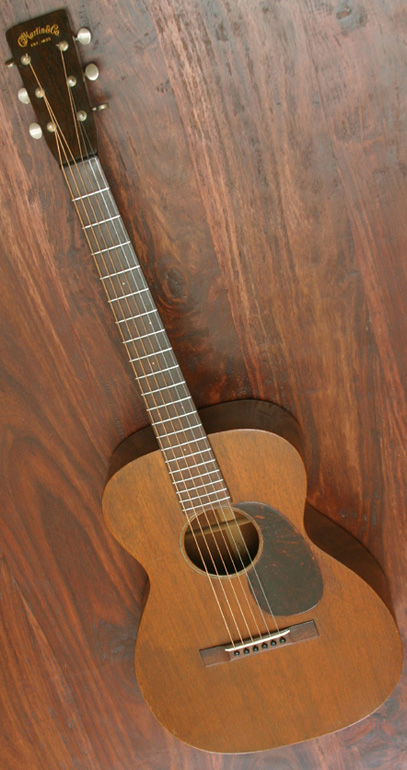 It’s rare to find a Golden Era Martin in this condition. This wonderful, completely crack-free 14-fret guitar from the 30’s is a gem. It’s one of the very first Martins of any style to have all three: 14 frets clear of body+Martin decal on the front of the peghead+Martin stamp the back of the peghead. Mahogany top, back and sides, of course, and it has the great, resonant feel and tone of a very lightly built 12-fret, but with more volume, in a 14-fret package. Strong bass response. 1 3/4 inch nut. Original finish, everywhere; no cracks anywhere. Original tuners. Original full-height bridge and maple bridge plate. Original bridge pins, and nut. The neck was recently set, so there is a new bone saddle, and the action is nice and low. Original bar frets. Some slight wear below the pick guard (not a hint of a crack or even any shrinking of the edges of the pick guard), and a variety of minor dings– but this completely crack-free guitar from the Martin Golden era is a gem.
It’s rare to find a Golden Era Martin in this condition. This wonderful, completely crack-free 14-fret guitar from the 30’s is a gem. It’s one of the very first Martins of any style to have all three: 14 frets clear of body+Martin decal on the front of the peghead+Martin stamp the back of the peghead. Mahogany top, back and sides, of course, and it has the great, resonant feel and tone of a very lightly built 12-fret, but with more volume, in a 14-fret package. Strong bass response. 1 3/4 inch nut. Original finish, everywhere; no cracks anywhere. Original tuners. Original full-height bridge and maple bridge plate. Original bridge pins, and nut. The neck was recently set, so there is a new bone saddle, and the action is nice and low. Original bar frets. Some slight wear below the pick guard (not a hint of a crack or even any shrinking of the edges of the pick guard), and a variety of minor dings– but this completely crack-free guitar from the Martin Golden era is a gem. -
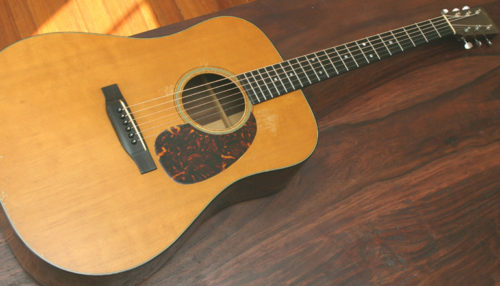 This big booming dreadnaught from one of Martin’s finest eras has everything you’d expect in volume, but it also has that wonderful sustain and ringing treble, and warm round bass, that only an almost-50-year-old Brazilian Rosewood Martin dreadnaught brings. All original throughout. Small 3 inch finish crack on lower back, stable. Typical B-string/pickguard crack, difficult to see, from bridge to beneath guard. Great original finish with minor dings and some minor pickwear around the soundhole. Ivory nut, full, original bridge and perfect condition maple bridge plate. The frets are in great condition. Rosewood fingerboard shows slight wear, nothing out of the ordinary. Frets are fine, showing minimal wear. Beautiful tortoiseshell binding in great condition, no separation anywhere. Inside of guitar shows all braces perfect–very clean and dust-free inside. Strap lug on heel and endpin. The neck was just set by Tony Nobles, and the action is low, with no buzzing. You can play it hard. It was fitted with a new bone saddle with the neck set (the original ivory saddle is in the case). Brazilian rosewood D-size Martins, from the era when Martin still used hide glue for guitar construction, are highly sought-after. This one, in this condition, will go quickly.
This big booming dreadnaught from one of Martin’s finest eras has everything you’d expect in volume, but it also has that wonderful sustain and ringing treble, and warm round bass, that only an almost-50-year-old Brazilian Rosewood Martin dreadnaught brings. All original throughout. Small 3 inch finish crack on lower back, stable. Typical B-string/pickguard crack, difficult to see, from bridge to beneath guard. Great original finish with minor dings and some minor pickwear around the soundhole. Ivory nut, full, original bridge and perfect condition maple bridge plate. The frets are in great condition. Rosewood fingerboard shows slight wear, nothing out of the ordinary. Frets are fine, showing minimal wear. Beautiful tortoiseshell binding in great condition, no separation anywhere. Inside of guitar shows all braces perfect–very clean and dust-free inside. Strap lug on heel and endpin. The neck was just set by Tony Nobles, and the action is low, with no buzzing. You can play it hard. It was fitted with a new bone saddle with the neck set (the original ivory saddle is in the case). Brazilian rosewood D-size Martins, from the era when Martin still used hide glue for guitar construction, are highly sought-after. This one, in this condition, will go quickly. -
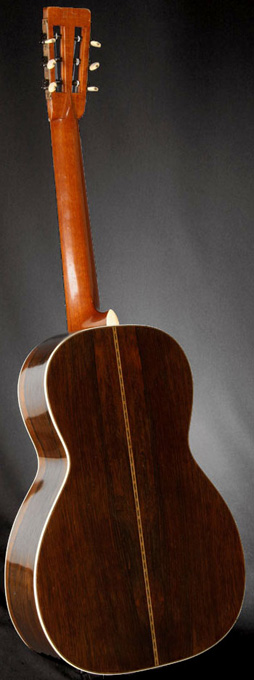 Signed by Martin factory foreman, underside of top: “6/1886”, this 0-28 is in stunning original condition. 1886 is the last year of the original factory in Nazareth, before Martin built the new factory addition in 1887. It is also the last year before they installed mechanized steam-run equipment to bend sides. So this wonderful 0-28, is one of the last of the totally hand-crafted Martins, built without mechanized equipment, and signed as such, 1886. Instrument is 100% original: finish, bridge, ivory nut, ivory saddle, ivory pins, bar frets, everything.
Signed by Martin factory foreman, underside of top: “6/1886”, this 0-28 is in stunning original condition. 1886 is the last year of the original factory in Nazareth, before Martin built the new factory addition in 1887. It is also the last year before they installed mechanized steam-run equipment to bend sides. So this wonderful 0-28, is one of the last of the totally hand-crafted Martins, built without mechanized equipment, and signed as such, 1886. Instrument is 100% original: finish, bridge, ivory nut, ivory saddle, ivory pins, bar frets, everything.- Crack-free
- repaired center seam on top
- Shows very little wear
- Scalloped braces (X-braced)
- original maple bridge plate
- original French-polish shellac finish throughout
- 13.5" wide at lower bout, and 4.25" deep at the endpin
- 24.9" scale length
- 1-7/8" wide nut
- soft-V neck profile.
-
 This fine Brazilian Rosewood 12-fret Martin is a joy to play, and it’s properly set up for steel strings. The grandson of C. F. Martin, Sr., Frank Henry Martin oversaw the Martin business from 1880 until well into twentieth century, and was responsible for the creation of the Style 0. I’m sure he loved this guitar–he personally signed the instrument, in cursive, under the top: “# 10082 Oct. 17th, 1905 F.H.M.” This 0-21 combines the exquisite tone of a 100 year old Martin, with some wonderful restoration. Guitar was refinished, probably decades ago, and it is a beautiful, French polish finish that has all the earmarks of an original finish. You can see the pores and saw marks in the Brazilian rosewood. No heavy-handed finish here, it’s a natural finish that lets the grain and color of the wood come through. And the tone, too, that sweet tone you can only get from Brazilian this old. The ebony pyramid bridge is a replacement, and features a compensated saddle, so intonation is dead on. (The bridge plate is the original small maple plate, in perfect condition.) Original tuners. Crack-free top and sides. There is only one very small crack, on the back, about 3 inches long, professionally repaired. The neck was set recently by Tony Nobles, and the original bar frets dressed. It plays, and sounds, like a late 20’s 12-fret Brazilian rosewood Martin.
This fine Brazilian Rosewood 12-fret Martin is a joy to play, and it’s properly set up for steel strings. The grandson of C. F. Martin, Sr., Frank Henry Martin oversaw the Martin business from 1880 until well into twentieth century, and was responsible for the creation of the Style 0. I’m sure he loved this guitar–he personally signed the instrument, in cursive, under the top: “# 10082 Oct. 17th, 1905 F.H.M.” This 0-21 combines the exquisite tone of a 100 year old Martin, with some wonderful restoration. Guitar was refinished, probably decades ago, and it is a beautiful, French polish finish that has all the earmarks of an original finish. You can see the pores and saw marks in the Brazilian rosewood. No heavy-handed finish here, it’s a natural finish that lets the grain and color of the wood come through. And the tone, too, that sweet tone you can only get from Brazilian this old. The ebony pyramid bridge is a replacement, and features a compensated saddle, so intonation is dead on. (The bridge plate is the original small maple plate, in perfect condition.) Original tuners. Crack-free top and sides. There is only one very small crack, on the back, about 3 inches long, professionally repaired. The neck was set recently by Tony Nobles, and the original bar frets dressed. It plays, and sounds, like a late 20’s 12-fret Brazilian rosewood Martin. -
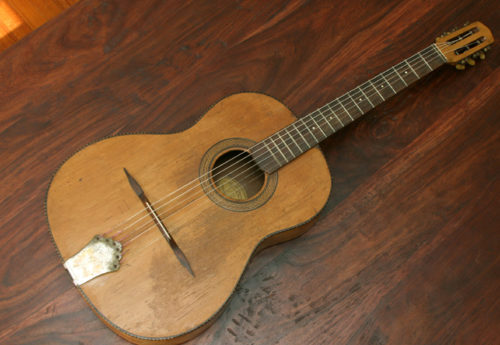 When Martin entered into its “Golden Age” for the flat top guitar, the jazz guitar was evolving on a parallel and equally important track. And in Europe, especially France, they had their own ideas about guitar making, and produced some brilliant guitars in this era–including of course the wonderful Selmer gypsy jazz guitar. The brothers Gerome were among the best luthiers in Mirecourt, France, a city famous in Europe for producing the finest gypsy and jazz guitars, in the 20s, 30s, and 40s. This all original, gypsy style guitar has maple back and sides, to give that high, twangy tone, just what you want in a django-style guitar. This one has loud piercing trebles–the treble strings are louder and more piercing than any guitar of any kind I have ever heard. Only maple produces that loud sharp treble. The volume of this instrument is striking, and there is almost a “reverb”, resonant quality to the tone. Solid spruce top. Black & white checkerboard marquetry binding on top, and rosette. It has a very thick rosewood fingerboard (over 4/10 inches/10.5mm thick!) Maple neck. Nut just shy of 1 7/8 inch. Wonderful bakelite buttons on the tuners. And it would not be a genuine gypsy jazz classic, if it did not have the hallmarks of this style: the original “floating bridge”–not an “adjustable brigde” for height, but a floating rosewood bridge that is not glued to the top, but held on by string tension (the “wings” of the bridge are glued to the top in this configuration). (You can of course change the intonation with this set-up.) The other feature that is a must, is the “zero fret”, i.e. there is a fret (the “zero” fret) right in front of the nut. 14-5/8 inch wide at lower bout. All original finish. A couple of small cracks on top. Top center seam repair. Original T-frets show wear, but still work fine. No buzzing. Action is good. Takes loop-end strings (available from many sources–Savarez Argentine strings are great on this instrument).
When Martin entered into its “Golden Age” for the flat top guitar, the jazz guitar was evolving on a parallel and equally important track. And in Europe, especially France, they had their own ideas about guitar making, and produced some brilliant guitars in this era–including of course the wonderful Selmer gypsy jazz guitar. The brothers Gerome were among the best luthiers in Mirecourt, France, a city famous in Europe for producing the finest gypsy and jazz guitars, in the 20s, 30s, and 40s. This all original, gypsy style guitar has maple back and sides, to give that high, twangy tone, just what you want in a django-style guitar. This one has loud piercing trebles–the treble strings are louder and more piercing than any guitar of any kind I have ever heard. Only maple produces that loud sharp treble. The volume of this instrument is striking, and there is almost a “reverb”, resonant quality to the tone. Solid spruce top. Black & white checkerboard marquetry binding on top, and rosette. It has a very thick rosewood fingerboard (over 4/10 inches/10.5mm thick!) Maple neck. Nut just shy of 1 7/8 inch. Wonderful bakelite buttons on the tuners. And it would not be a genuine gypsy jazz classic, if it did not have the hallmarks of this style: the original “floating bridge”–not an “adjustable brigde” for height, but a floating rosewood bridge that is not glued to the top, but held on by string tension (the “wings” of the bridge are glued to the top in this configuration). (You can of course change the intonation with this set-up.) The other feature that is a must, is the “zero fret”, i.e. there is a fret (the “zero” fret) right in front of the nut. 14-5/8 inch wide at lower bout. All original finish. A couple of small cracks on top. Top center seam repair. Original T-frets show wear, but still work fine. No buzzing. Action is good. Takes loop-end strings (available from many sources–Savarez Argentine strings are great on this instrument). -
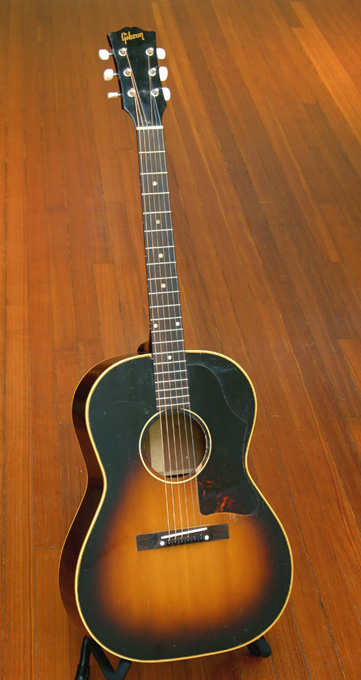 A wonderful, completely crack-free LG-2. The neck was recently set by Mark Erlewine, the frets dressed, and a new saddle installed ... beautifully set up by ME. 1-11/16 inch nut. Mahogany back and sides. Spruce top. Low action, with no buzzing. Nice sustain, and volume.
A wonderful, completely crack-free LG-2. The neck was recently set by Mark Erlewine, the frets dressed, and a new saddle installed ... beautifully set up by ME. 1-11/16 inch nut. Mahogany back and sides. Spruce top. Low action, with no buzzing. Nice sustain, and volume. -
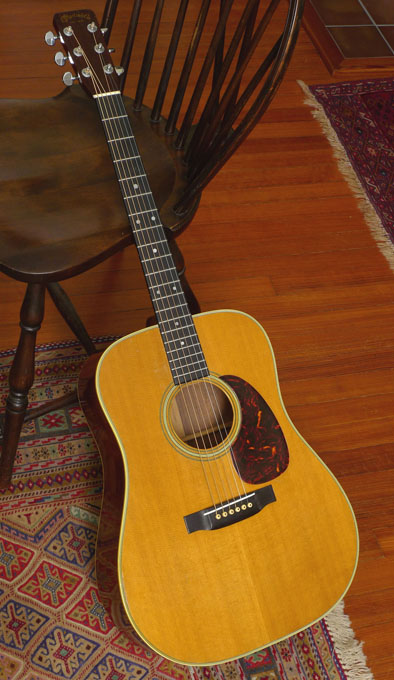 This Brazilian Rosewood D-28 dreadnaught from one of Martin’s finest eras, is special. Its structural integrity, and originality, are rare. And it’s one of the last Martin D-28’s made when Martin still used hide glue for guitar construction. This is a one-owner guitar, still in its original case. When we acquired it, it had not been played for years. Its original bridge, had a split in it, and had come loose from the top. Thus, it sat unplayed in its case for years. But all the wood beneath the bridge was pristine, perfect. So John Allison just made and installed a new exact reproduction bridge, from dark African ebony. It’s perfect, using the exact footprint of the original. The new bridge was attached with hide glue. And we used the original bridge pins.
This Brazilian Rosewood D-28 dreadnaught from one of Martin’s finest eras, is special. Its structural integrity, and originality, are rare. And it’s one of the last Martin D-28’s made when Martin still used hide glue for guitar construction. This is a one-owner guitar, still in its original case. When we acquired it, it had not been played for years. Its original bridge, had a split in it, and had come loose from the top. Thus, it sat unplayed in its case for years. But all the wood beneath the bridge was pristine, perfect. So John Allison just made and installed a new exact reproduction bridge, from dark African ebony. It’s perfect, using the exact footprint of the original. The new bridge was attached with hide glue. And we used the original bridge pins.- Guitar is 100% crack-free (no, not even a pickguard crack)
- 100% original finish, everywhere. No overspray or finish alterations of any kind. Minor dings and some minor pickwear around the soundhole.
- Has never had a strap lug attached
- Perfect condition maple bridge plate
- Original frets are in great condition
- Action is great, with just the right amount of saddle, and neck angle is perfect
-
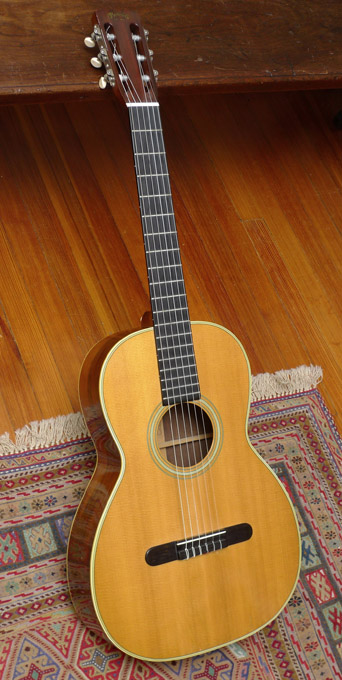 Another wonderful instrument with top grade Brazilian Rosewood back and sides. The Brazilian rosewood on this in instrument is more figured on the sides, and the back shows wonderful bookmatched figuring. This is an all-original guitar. There are no cracks that go through the wood. There are several finish/superficial cracks in the finish, one on the top near the bottom/endpin area, and one on the back. And a bit of crazing in the top finish. Set-up and playability is great. Wonderful full tonal range up and down the fretboard.
Another wonderful instrument with top grade Brazilian Rosewood back and sides. The Brazilian rosewood on this in instrument is more figured on the sides, and the back shows wonderful bookmatched figuring. This is an all-original guitar. There are no cracks that go through the wood. There are several finish/superficial cracks in the finish, one on the top near the bottom/endpin area, and one on the back. And a bit of crazing in the top finish. Set-up and playability is great. Wonderful full tonal range up and down the fretboard. -
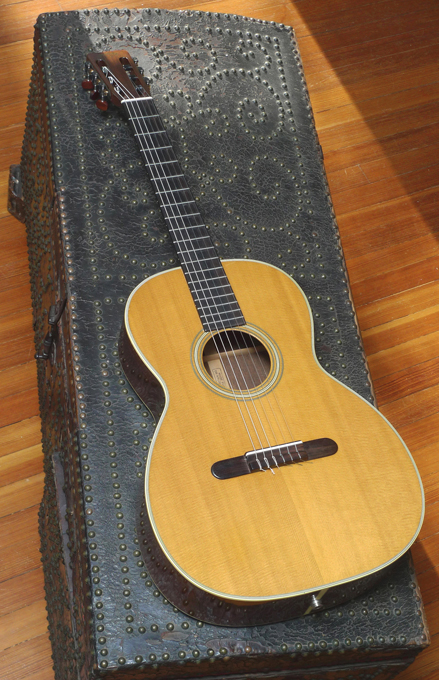 A wonderfully preserved, crack free 12 fret 000-28 Martin, with gorgeous Brazilian rosewood back and sides. The tone of this instrument is wonderful. It stands up to many high end Spanish made classical guitars of the period for Brazilian rosewood warmth. While intentionally not built for concert hall volume, the bass tone and clarity of the trebles on large-bodied Martin nylon strings guitars with Brazilian back and sides is unsurpassed. This instrument is very well set up to play on stage, plugged in, and to record, if desired. It has great high end Gilbert tuners, with black housing, abalone dot and snakewood buttons. (Original tuners, in perfect condition, are in the case, so you can easily replace the originals if desired.) This instrument has an excellent custom engineered stereo pickup system, installed without altering the guitar: The pickup is the undersaddle type, supplied by EMG. The separate mic element is assembled in a foam mounting block with cable, endpin jack, custom made for this guitar. It is unobtrusive in its mounting. Jack is mounted in the endpin hole, so there are no extra holes in the guitar. The output jack is stereo, TRS (Tip wired to pickup, Ring wired to mic, and Sleeve is ground.) The addition of the internal mic adds a realism and depth that no pickup by itself can capture. The EMG pickup is excellent compared to most others in terms of exhibiting less of that harsh piezo sound. The result is a guitar that plays beautifully amplified, or on its own. The Martin “C” has the old elongated Martin 12 fret body. It was offered in the 00-16C, 00-18C and 000-28C in 1962. 1966 saw the last 000-28C. There were not many nylon string, 000-sized 28 models made, and fewer still with the quality of Brazilian rosewood this one has. And the condition on this instrument is stunning. No cracks anywhere, and very little wear at all.
A wonderfully preserved, crack free 12 fret 000-28 Martin, with gorgeous Brazilian rosewood back and sides. The tone of this instrument is wonderful. It stands up to many high end Spanish made classical guitars of the period for Brazilian rosewood warmth. While intentionally not built for concert hall volume, the bass tone and clarity of the trebles on large-bodied Martin nylon strings guitars with Brazilian back and sides is unsurpassed. This instrument is very well set up to play on stage, plugged in, and to record, if desired. It has great high end Gilbert tuners, with black housing, abalone dot and snakewood buttons. (Original tuners, in perfect condition, are in the case, so you can easily replace the originals if desired.) This instrument has an excellent custom engineered stereo pickup system, installed without altering the guitar: The pickup is the undersaddle type, supplied by EMG. The separate mic element is assembled in a foam mounting block with cable, endpin jack, custom made for this guitar. It is unobtrusive in its mounting. Jack is mounted in the endpin hole, so there are no extra holes in the guitar. The output jack is stereo, TRS (Tip wired to pickup, Ring wired to mic, and Sleeve is ground.) The addition of the internal mic adds a realism and depth that no pickup by itself can capture. The EMG pickup is excellent compared to most others in terms of exhibiting less of that harsh piezo sound. The result is a guitar that plays beautifully amplified, or on its own. The Martin “C” has the old elongated Martin 12 fret body. It was offered in the 00-16C, 00-18C and 000-28C in 1962. 1966 saw the last 000-28C. There were not many nylon string, 000-sized 28 models made, and fewer still with the quality of Brazilian rosewood this one has. And the condition on this instrument is stunning. No cracks anywhere, and very little wear at all. -
Out of stock
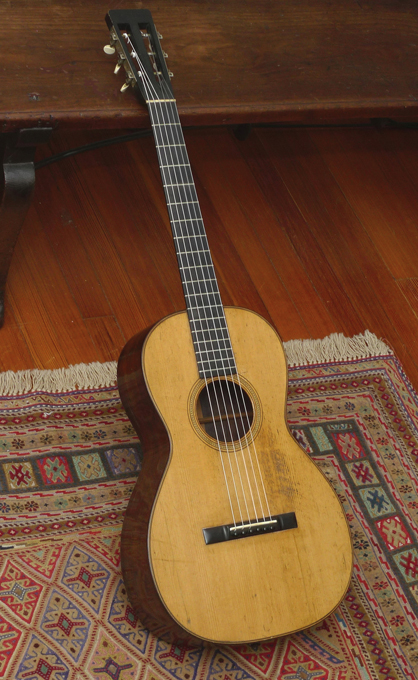 1855-1860 Martin “transitional”1-21. A very rare and exquisite large size Martin from the pre-1867 era. “Large size” Martin from the 1850’s, because the Size 1, and 0, were the only “large” size Martins in those years. And there is currently not a single other size 1 or 0 size pre-1867 Martin guitar on the market. This is considered by the top U.S. experts who vetted this instrument as an early, rare "transitional" 1-21, based on the fact that it does not have all the later, standardized, 1860’s and on “21” attributes– specifically, backstrip and endwedge on this instrument are not typical of “price-list” era 21’s (after the publishing of the first Martin price lists, establishing features of the different models, in the 1860’s) This 1-21 has:
1855-1860 Martin “transitional”1-21. A very rare and exquisite large size Martin from the pre-1867 era. “Large size” Martin from the 1850’s, because the Size 1, and 0, were the only “large” size Martins in those years. And there is currently not a single other size 1 or 0 size pre-1867 Martin guitar on the market. This is considered by the top U.S. experts who vetted this instrument as an early, rare "transitional" 1-21, based on the fact that it does not have all the later, standardized, 1860’s and on “21” attributes– specifically, backstrip and endwedge on this instrument are not typical of “price-list” era 21’s (after the publishing of the first Martin price lists, establishing features of the different models, in the 1860’s) This 1-21 has:- Diamond marquetry backstrip (not found on later, 1860’s 1-21s)
- Marquetry endwedge (not found on later, 1860’s 1-21s) (Wood end wedge and herringbone backstrip were the standard features of the 1860’s and after 1-21’s)
- X-braced. All braces are 100% original. No internal repairs to braces.
- Slot head
- Ebonized neck (maple neck, ebonized, i.e. painted black). This is another transitional feature: black neck was replaced by cedar on Style 21 by the time the Martin price list was first printed.
- Single "tone bar" brace behind the bridge plate
- Ice cream cone-shaped heel (1860’s 1-21’s had cedar neck, with Spanish style heel not ice cream cone heel)
- Three "CF Martin New-York" stamps: one inside center strip; the second on neck block (this stamp is upside down, as it should be); the third on back of guitar (near heel), the third stamp transversing the backstrip on the back of the guitar near the heel.
- Solid Brazilian Rosewood back and sides
- All original finish, everywhere; no touch-ups, overspray, etc, of any kind ever done
- Brazilian rosewood back shows beautiful sawmarks
- Bridge, more than a century old, is probably a replacement bridge… but on the original bridge footprint
- Original ivory nut
- Original bridge plate (mahogany)
- No back cracks, or side cracks; one top crack, repaired
- Tuners are modern replacements, vintage style, in original slot holes
- Original frets
-
 A wonderfully balanced and resonant Martin 00-28G, with some of the most beautiful Brazilian rosewood you’ll see on any Martin guitar, and in wonderful, crack-free, original condition. The Martin “G” is very different from the “C”. The “C” has the Martin 12 fret body. The “G” model used the 14-fret style body shape, but with the 12 fret neck, slotted headstock, and 25.4 inch scale. The 00-28G was first produced by Martin in 1936, and was discontinued in 1962, when Martin went to all “C” style for nylon string guitars. The 00-28G was Martin’s top of line model for nylon strings, from 1936, to 1962… and this guitar is the best example available on the market. The condition on this instrument is superb. No cracks anywhere, and very little wear at all... it's almost perfect. All original, tuners, nut, bridge, saddle, etc. Neck is perfect, has never been set, and shows perfect set up and action.
A wonderfully balanced and resonant Martin 00-28G, with some of the most beautiful Brazilian rosewood you’ll see on any Martin guitar, and in wonderful, crack-free, original condition. The Martin “G” is very different from the “C”. The “C” has the Martin 12 fret body. The “G” model used the 14-fret style body shape, but with the 12 fret neck, slotted headstock, and 25.4 inch scale. The 00-28G was first produced by Martin in 1936, and was discontinued in 1962, when Martin went to all “C” style for nylon string guitars. The 00-28G was Martin’s top of line model for nylon strings, from 1936, to 1962… and this guitar is the best example available on the market. The condition on this instrument is superb. No cracks anywhere, and very little wear at all... it's almost perfect. All original, tuners, nut, bridge, saddle, etc. Neck is perfect, has never been set, and shows perfect set up and action. -
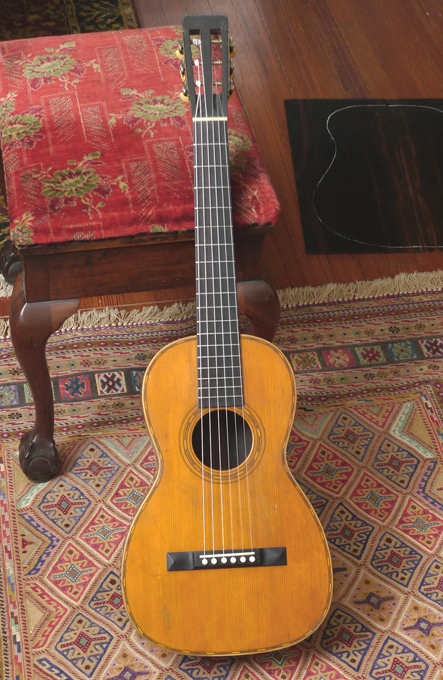 A rare, wonderfully-preserved, 1854 Schmidt & Maul. It’s signed and dated inside: Louis Schmidt Tompkinsville Staten Island New York 388 Broadway August 18th 1854 U. S.
A rare, wonderfully-preserved, 1854 Schmidt & Maul. It’s signed and dated inside: Louis Schmidt Tompkinsville Staten Island New York 388 Broadway August 18th 1854 U. S.- Adirondack top
- Ebonized “ice cream cone” style neck
- solid brazilian rosewood back and sides
- fan braced
- marquetry Purfling around top, with Maple binding
- Maple binding, back
- Width at lower bout: 11 ½ inches
- 100% original finish. No overspray, touch-up, etc. anywhere…wonderful finish
- Not a crack on top, or sides. One small dryness crack on back, near the edge binding on treble side
- Original bridge plate, in great condition
- Reproduction, correct, Ebony bridge
- Bar frets replaced with period correct Bar frets from TJ Thompson
-
 We called it the “Tony Rice” prewar 000-18. Is it the "tony rice" style slightly enlarged soundhole (done decades ago). All original finish.
We called it the “Tony Rice” prewar 000-18. Is it the "tony rice" style slightly enlarged soundhole (done decades ago). All original finish. -
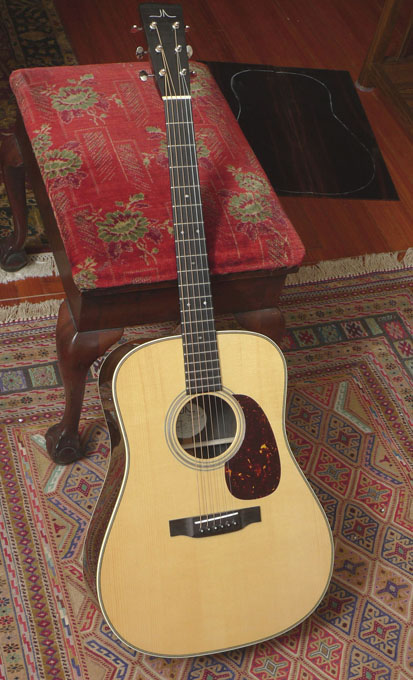 This is a new Allison Brazilian Rosewood dreadnought. Austin-based John Allison was a key part of the Collings Guitar team for years. John is now one of the most sought-after independent makers of fine instruments in the southwest. His guitars are carried by a number of top dealers in the U.S… and we’ve just snagged this brand new, wonderful Brazilian– a custom order guitar. Allison’s attention to detail is astounding. You just have to see and play this great brazilian. Right off the bench, it’s loud and beguiling, and it will only get better over time.
This is a new Allison Brazilian Rosewood dreadnought. Austin-based John Allison was a key part of the Collings Guitar team for years. John is now one of the most sought-after independent makers of fine instruments in the southwest. His guitars are carried by a number of top dealers in the U.S… and we’ve just snagged this brand new, wonderful Brazilian– a custom order guitar. Allison’s attention to detail is astounding. You just have to see and play this great brazilian. Right off the bench, it’s loud and beguiling, and it will only get better over time.- Top: Adirondack Spruce
- Back, and Sides: Brazilian Rosewood
- Bracing: Scalloped X, Adirondack
- Neck: Mahogany
- Finish: Nitrocellulose lacquer
- Herringbone purfling
- Ivoroid binding
- Fretboard: Ebony
- Bridge: Ebony
- Peghead veneer: Ebony
- Scale Length: 25.5 inches
- Nut Width: 1 11/16 inches
- Tuners: Waverly
-
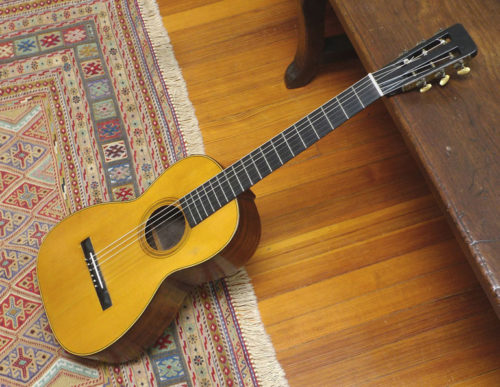 This guitar is the last known guitar in existence, made by Louis Schmidt, the famous contemporary and one-time colleague to the founder of Martin Guitars, the original C.F. Martin. As such, it is a rare example of early American guitar making. And it’s signed by the maker, on the underside of the Adirondack top: Louis Schmidt Wakefield Westchester Cy NY July 9th 1859 U.S. Louis Schmidt worked side by side with CF Martin in the early years. Perhaps the most common misconception about early American guitar history is that C. F. Martin spent his first years in America earning a living as a solitary luthier in his New York workshop. Pay ledgers reveal that as early as 1834 he was paying luthiers to help him make his guitars. Two of these men, Heinrich Schatz and Louis Schmidt, left Martin's employ to make guitars on their own, and each succeeded as top builders. This instrument:
This guitar is the last known guitar in existence, made by Louis Schmidt, the famous contemporary and one-time colleague to the founder of Martin Guitars, the original C.F. Martin. As such, it is a rare example of early American guitar making. And it’s signed by the maker, on the underside of the Adirondack top: Louis Schmidt Wakefield Westchester Cy NY July 9th 1859 U.S. Louis Schmidt worked side by side with CF Martin in the early years. Perhaps the most common misconception about early American guitar history is that C. F. Martin spent his first years in America earning a living as a solitary luthier in his New York workshop. Pay ledgers reveal that as early as 1834 he was paying luthiers to help him make his guitars. Two of these men, Heinrich Schatz and Louis Schmidt, left Martin's employ to make guitars on their own, and each succeeded as top builders. This instrument:- Similar features to circa 1860 Martin 17 style... but different purfling, binding, and slightly different body shape
- All original finish
- Brazilian rosewood back and sides (solid); Adirondack top
- In its original coffin case
- 11 3/8 inches wide at lower bout (a bit larger than a Martin 2 1/2)
- Body: 3 7/8 inches deep
- Original mahogany bridge plate (goes almost all the way across the width of the top, slotted under all the braces)
- Fan bracing pattern
- Plays beautifully. Good bass tone. Action is perfect.
- Ebony Bridge has been off at some point, and reglued on. With a lack of similar guitars on the market, it’s not known if this 19th century bridge on the instrument is the original bridge.
- One repaired crack on top, from bridge to bottom binding; One repaired crack on back. One small crack on top, either top edge of soundhole.
- Original Jerome tuners, reverse gear, working perfectly
- Maple and rosewood purfling/binding on top (no binding on back)
-
 A chance to own a great sounding, great playing Brazilian Rosewood D-28, at a fraction of the cost of an all-original example. This D-28 has had some work, and a few issues, but it’s all repaired and ready to play. And the tone is incredible– tone you won’t find in any other mid-50’s D-28. This guitar, has just been gone over head to end pin, repaired, restored, and set up, by two of the top luthiers/repairmen in Texas, and it’s good to go for decades. The bridge is perfect. Saddle is perfect height. Action is great– low but no buzzing. It won’t need a thing. Ready to play. The tone: the scalloped braces add roundness and clarity to the basses (A and D string in particular) and a bit more “ring” to the trebles. Don’t try this at home– a scalloped braced mid 50’s D-28, but the result, set up by two of this country’s top luthiers, is a great sounding brazilian Martin dread, whose tone you won’t find in any Martin north of 1944– certainly not at this price. Here’s the report:
A chance to own a great sounding, great playing Brazilian Rosewood D-28, at a fraction of the cost of an all-original example. This D-28 has had some work, and a few issues, but it’s all repaired and ready to play. And the tone is incredible– tone you won’t find in any other mid-50’s D-28. This guitar, has just been gone over head to end pin, repaired, restored, and set up, by two of the top luthiers/repairmen in Texas, and it’s good to go for decades. The bridge is perfect. Saddle is perfect height. Action is great– low but no buzzing. It won’t need a thing. Ready to play. The tone: the scalloped braces add roundness and clarity to the basses (A and D string in particular) and a bit more “ring” to the trebles. Don’t try this at home– a scalloped braced mid 50’s D-28, but the result, set up by two of this country’s top luthiers, is a great sounding brazilian Martin dread, whose tone you won’t find in any Martin north of 1944– certainly not at this price. Here’s the report:- sometime decades ago, the top braces were scalloped
- probably as a result of a minor impact at the end pin (guitar dropped), there were cracks in the sides, and a slight crack to the neck block. So a previous luthier, long before we acquired the guitar, put in 4 small wood dowels, through the sides–near the heel, into the block (see photos). All is stable. Not the prettiest solution, but it works well.
- Small crack in heel, repaired and stable
- Original finish, on Sitka Spruce top; Oversprayed back, sides, and neck (but back of neck finish has worn, giving a natural, comfortable feel)
- A bit of damage to one corner of the headstock. But there are no cracks in headstock.
- Pickup jack installed years ago at end pin; no pickup inside; Also, an old pickup jack on bass side of guitar, filled.
- Some pickwear loss, bottom edge of soundhole
- Top of guitar has no serious cracks. No "B string" pickguard crack. Tiny crack along the treble edge of the pick guard. A couple more finish type of cracks that do not go through the wood to inside.
- Several side cracks, all addressed.
- Back of guitar has no cracks through the wood. A couple of finish cracks.
- neck set, by John Allison
- Refret, by John Allison
- New, 100% period correct, ebony bridge, made and installed by John Allison. Bridge is made to the exact specs, footprint, etc, of an original 1956 Martin bridge. A small area of finish around an older oversized bridge was addressed by John (you can see this in the photos).
- New, period correct Maple bridge plate, installed by Tony Nobles
- Old pickup jack on bass side of guitar, filled by Tony Nobles.
- The wonderful, original gold-plated Kluson waffle-back tuners, are original, and work perfectly.
- Original pickguard
- Original Martin logo on headstock
-
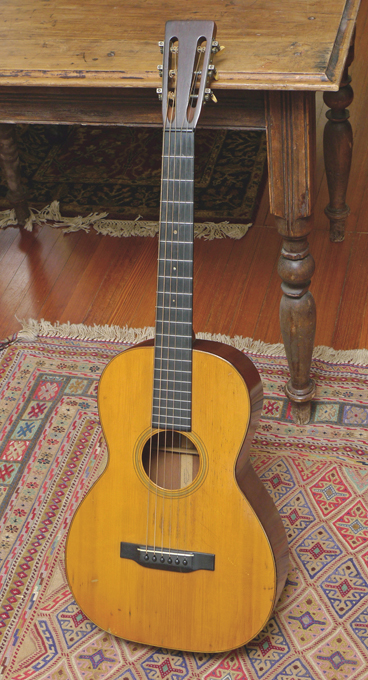 An all-original Martin from the finest era in the company’s history, this 0-18 is unsurpassed for Martin 12-fret Adirondack spruce over Mahogany tone. What can you add about a 1930 Martin, that is 100% original, down to the original bridge pins, and original ivory saddle This example is from the time when Martin had just started using belly bridges, and the ebony belly bridge on this guitar still has its original ivory saddle. And this guitar is 100% crack-free. Period. The instrument features the original bridge (full height), original tuners, original ivory saddle, original nut, and original maple bridge plate (the bridge plate shows almost no wear from ball ends–almost unheard of in a prewar Martin). All original finish– everywhere. Some honest playwear and various minor nicks and dings give the wonderfully aged and naturally honey-hued Adirondack top character. The top shows perfect form, with no bellying behind the bridge, etc. One of the things that makes Martin’s from these year so great-sounding: Martin was still using a thin ebony rod inside the neck, not a metal bar. So the instrument is more free to resonate, from tuners, right down to the bridge. And resonate this one does, with a strong bass especially that puts many many large size guitars to shame. 1-7/8 inch nut. The neck has just been set, by us, retaining the original Bar frets
An all-original Martin from the finest era in the company’s history, this 0-18 is unsurpassed for Martin 12-fret Adirondack spruce over Mahogany tone. What can you add about a 1930 Martin, that is 100% original, down to the original bridge pins, and original ivory saddle This example is from the time when Martin had just started using belly bridges, and the ebony belly bridge on this guitar still has its original ivory saddle. And this guitar is 100% crack-free. Period. The instrument features the original bridge (full height), original tuners, original ivory saddle, original nut, and original maple bridge plate (the bridge plate shows almost no wear from ball ends–almost unheard of in a prewar Martin). All original finish– everywhere. Some honest playwear and various minor nicks and dings give the wonderfully aged and naturally honey-hued Adirondack top character. The top shows perfect form, with no bellying behind the bridge, etc. One of the things that makes Martin’s from these year so great-sounding: Martin was still using a thin ebony rod inside the neck, not a metal bar. So the instrument is more free to resonate, from tuners, right down to the bridge. And resonate this one does, with a strong bass especially that puts many many large size guitars to shame. 1-7/8 inch nut. The neck has just been set, by us, retaining the original Bar frets -
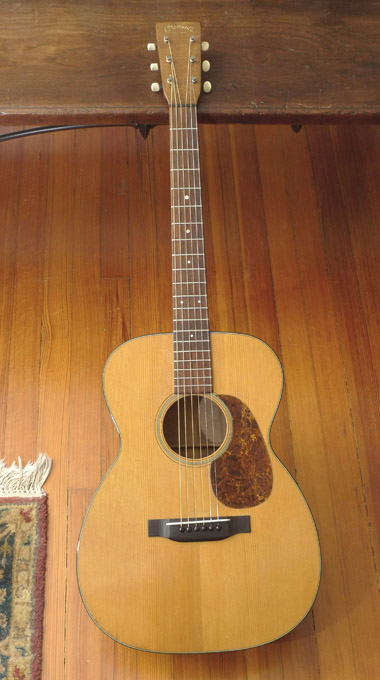 This is a prime example of why the pre-war, scalloped brace Martins made in 1943 in particular are the best sounding Martins ever: the ebony truss rod in the neck (instead of a metal truss rod– due to wartime metal rationing), the even more finely scalloped tone bars, and lack of metal tuner post bushings, all contribute to the lightness of build, and the robust tone, resonance and sustain you won’t find on any other Martin (not even the mid-30’s Martins). This guitar, seemingly light as a feather, plays like a dream, and is particularly resonant, and wonderful, for fingerpicking. (Martins from this year, often have a thinner finish, as does this one, which also contributes to its almost Shaker-like simplicity and beauty.) All original finish still in great shape. It has just had a new, Brazilian rosewood bridge made (from 100 year old, old-growth Brazilian rosewood, to the exact shape and footprint of the original which had a crack and was better replaced) by Tony Nobles (original bridge will ship, in the case). The bridge is hide-glued on, naturally. Aside from the typical B-string area “pickguard crack”, now well repaired and a non-issue, the top of the guitar is crack free. There is one well-repaired crack on the back. There was an old input jack right below the end pin, now filled expertly by Nobles (but no evidence of any pickups etc inside the guitar).
This is a prime example of why the pre-war, scalloped brace Martins made in 1943 in particular are the best sounding Martins ever: the ebony truss rod in the neck (instead of a metal truss rod– due to wartime metal rationing), the even more finely scalloped tone bars, and lack of metal tuner post bushings, all contribute to the lightness of build, and the robust tone, resonance and sustain you won’t find on any other Martin (not even the mid-30’s Martins). This guitar, seemingly light as a feather, plays like a dream, and is particularly resonant, and wonderful, for fingerpicking. (Martins from this year, often have a thinner finish, as does this one, which also contributes to its almost Shaker-like simplicity and beauty.) All original finish still in great shape. It has just had a new, Brazilian rosewood bridge made (from 100 year old, old-growth Brazilian rosewood, to the exact shape and footprint of the original which had a crack and was better replaced) by Tony Nobles (original bridge will ship, in the case). The bridge is hide-glued on, naturally. Aside from the typical B-string area “pickguard crack”, now well repaired and a non-issue, the top of the guitar is crack free. There is one well-repaired crack on the back. There was an old input jack right below the end pin, now filled expertly by Nobles (but no evidence of any pickups etc inside the guitar).- Original bridge plate, in fine condition. Original Frets.
- Original tuners (it looks like at one point there were other tuners on the guitar… with a few old screw holes filled.)
- Has never had strap lug attached to heel
- Top shows no “bellying”. Natural shape and slight arch is textbook perfect.
-
Out of stock
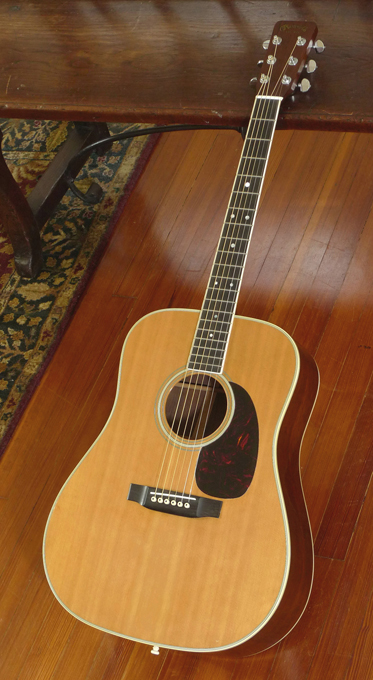 If there is a mid-60’s Brazilian Rosewood D-35 in better original condition out there than this one– it would have to be new. About as close to mint as you can get, this guitar shows little wear. And the Brazilian on back and sides– wonderful specimens, not the “figured” stuff you see on many later 60’s Martins. Not a crack, or hint of crack, anywhere (no, not even the typical “pickguard” crack). Original bridge, tuners, etc. Original frets show almost no wear. All original finish everywhere–and note that the finish does not have any of that “crazing” you often see on the original finishes of mid-60’s Martins. It has never had strap lugs attached. It has the more desirable original tortoise pickguard (Martin changed to black pickguards, later in 1967). Original small maple bridge plate, in original condition. The tone of this guitar, is wonderful. Ringing trebles like the very best brazilian Martin dread’s. And a bass response that shows why Martin brought out this model, in 1965, as an even higher-end model (and with lighter bracing) than the D-28. There are few tiny dings near the edge of the lower bout, on top (too small to photograph well). But a D-35 in better condition than this one would have to be off the factory floor. Action is perfect. Neck straight. Ready to play.
If there is a mid-60’s Brazilian Rosewood D-35 in better original condition out there than this one– it would have to be new. About as close to mint as you can get, this guitar shows little wear. And the Brazilian on back and sides– wonderful specimens, not the “figured” stuff you see on many later 60’s Martins. Not a crack, or hint of crack, anywhere (no, not even the typical “pickguard” crack). Original bridge, tuners, etc. Original frets show almost no wear. All original finish everywhere–and note that the finish does not have any of that “crazing” you often see on the original finishes of mid-60’s Martins. It has never had strap lugs attached. It has the more desirable original tortoise pickguard (Martin changed to black pickguards, later in 1967). Original small maple bridge plate, in original condition. The tone of this guitar, is wonderful. Ringing trebles like the very best brazilian Martin dread’s. And a bass response that shows why Martin brought out this model, in 1965, as an even higher-end model (and with lighter bracing) than the D-28. There are few tiny dings near the edge of the lower bout, on top (too small to photograph well). But a D-35 in better condition than this one would have to be off the factory floor. Action is perfect. Neck straight. Ready to play. -
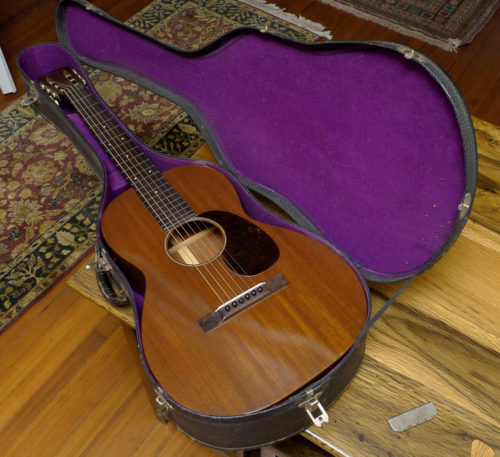 If there is a better-preserved Martin guitar from 1937, we have not seen it. This instrument is as an almost time-capsule condition 0-17H, still in its original case. And of course with its original Hawaiian set up. Many people convert these pre-war Martin Hawaiian set up guitars, to “Spanish” style, i.e. regular steel-string flat top set up. And that is certainly an option for whoever acquires this instrument. But this example, is just too nice, and too original for us to want to convert it. And the tone is exquisite (On request, we’ll send you a link to a video/audio clip of one of this country’s best, most famous dobro/pedal steel players playing slide on this great Martin 0-17H, right here in our shop.) All mahogany of course: mahogany back, sides, and top. Brazilian rosewood bridge, and fretboard. The guitar has no play wear. We won’t call it pristine– even under-the bed-guitars that have not really been played, have a few nicks from just being in the case and moved around a couple of times in 70+ years. But it’s as close to perfect as you’ll find in any 1930’s Martin. The neck is straight as an arrow, showing no bowing at all. No cracks of any kind. All original parts, period– down to the nut, bridge pins, and ivory saddle. The guitar is 12 fret to the body, unlike the regular 0-17’s from this period that were 14-fret.
If there is a better-preserved Martin guitar from 1937, we have not seen it. This instrument is as an almost time-capsule condition 0-17H, still in its original case. And of course with its original Hawaiian set up. Many people convert these pre-war Martin Hawaiian set up guitars, to “Spanish” style, i.e. regular steel-string flat top set up. And that is certainly an option for whoever acquires this instrument. But this example, is just too nice, and too original for us to want to convert it. And the tone is exquisite (On request, we’ll send you a link to a video/audio clip of one of this country’s best, most famous dobro/pedal steel players playing slide on this great Martin 0-17H, right here in our shop.) All mahogany of course: mahogany back, sides, and top. Brazilian rosewood bridge, and fretboard. The guitar has no play wear. We won’t call it pristine– even under-the bed-guitars that have not really been played, have a few nicks from just being in the case and moved around a couple of times in 70+ years. But it’s as close to perfect as you’ll find in any 1930’s Martin. The neck is straight as an arrow, showing no bowing at all. No cracks of any kind. All original parts, period– down to the nut, bridge pins, and ivory saddle. The guitar is 12 fret to the body, unlike the regular 0-17’s from this period that were 14-fret. -
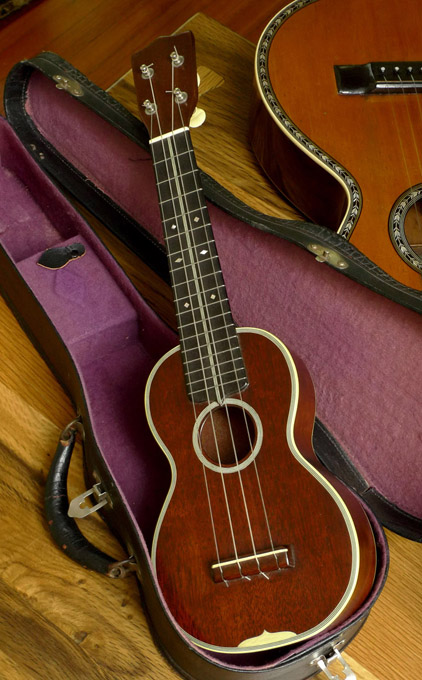 In the 1920’s and early 30's, the Hawaiian craze was in full bloom, and ukulele production was crucial to Martin’s success in this period. This is a wonderful, extremely well-preserved example of one of the most ornate of the Martin ukuleles, still in its original Geib case. Although Martin ukes built after 1916 carried no serial number, it’s possible to generally date them by stylistic elements. This Martin Style 3 is from the best era, the golden era, from about 1925 to 1930. Martin style 3 was first made in 1918. Martin Style 3, soprano (standard) specs:
In the 1920’s and early 30's, the Hawaiian craze was in full bloom, and ukulele production was crucial to Martin’s success in this period. This is a wonderful, extremely well-preserved example of one of the most ornate of the Martin ukuleles, still in its original Geib case. Although Martin ukes built after 1916 carried no serial number, it’s possible to generally date them by stylistic elements. This Martin Style 3 is from the best era, the golden era, from about 1925 to 1930. Martin style 3 was first made in 1918. Martin Style 3, soprano (standard) specs:- Mahogany body
- 7 layer top binding
- 3 layer back binding
- Ebony fretboard
- 5 layer soundhole ring
- Celluloid ornament on top, behind bridge (known as the "parend", or “shield”)
- Bar frets
- Small pearl paired-diamond inlays at fret 5, 7, and 9
- Three lines inlaid down center of fingerboard
- Nickel plated pegs (introduced in 1923)
- CF Martin & Co, stamped on back of peghead, and inside-back (Martin logo was not put on front of peghead until 1932)